2003 PONTIAC GRAND PRIX fog light
[x] Cancel search: fog lightPage 124 of 378

The main components of the instrument panel are
the following:
A. Side Window Defogger Outlets
B. Fog Lamps Switch
C. Turn SignaVMultifunction Lever
D. Instrument Panel Cluster
E. Hazard Warning Button
F. Horn
G. Trip Computer (If Equipped) and/or Driver
Information Center (DIC)
H. Instrument Panel Outlets
I. Interior Lamps Control
J. Exterior Lamps Control
K. Tilt Steering Wheel Control
L. Audio Steering Controls
(If Equipped)
M. Head Up Display (HUD) Controls (Option)
N. Climate Controls
0. Ashtray and Cigarette Lighter
P. Audio System
Q. Glove Box
R. Instrument Panel Fuse Block
Hazard Warning Flashers
Your hazard warning flashers let you warn others. They
also let police know you have a problem. Your front
and rear turn signa! !amps
will flash or! and off.
The hazard warning
flasher button is
located on top of the
steering column.
The hazard warning flashers work no matter what
position your key is in, and even
if the key isn’t in.
Press the button to make your front and rear turn signal
lamps flash on and
off. Press the button again to turn
the flashers
off.
When the hazard warning flashers are on, your turn
signals and brake lamps won’t work.
3-3
Page 127 of 378
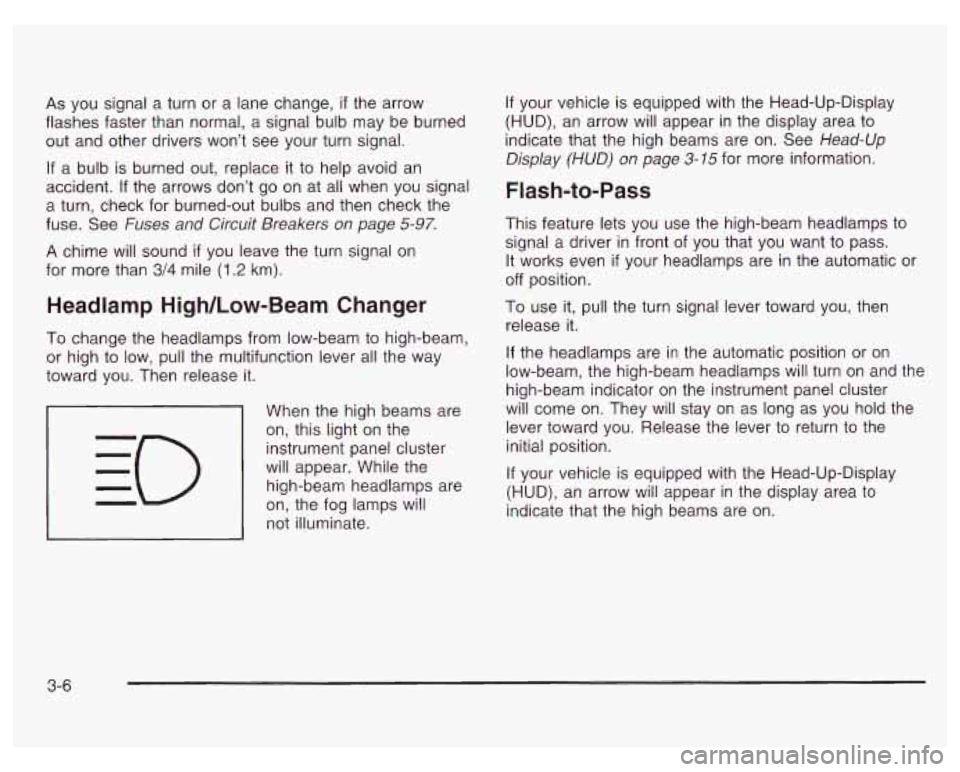
As you signal a turn or a lane change, if the arrow
flashes faster than normal, a signal bulb may be burned
out and other drivers won’t see your turn signal.
If a bulb is burned out, replace it to help avoid an
accident.
If the arrows don’t go on at all when you signal
a turn, check for burned-out bulbs and then check the
fuse. See Fuses and Circuit Breakers
on page 5-97.
A chime will sound if you leave the turn signal on
for more than
3/4 mile (1.2 km).
Headlamp High/Low-Beam Changer
To change the headlamps from low-beam to high-beam,
or high to low, pull the multifunction lever
all the way
toward you. Then release it.
When the high beams are
on, this light on the
instrument panel cluster
will appear. While the high-beam headlamps are
on, the fog lamps will
not illuminate.
If your vehicle is equipped with the Head-Up-Display
(HUD), an arrow will appear in the display area to
indicate that the high beams are on. See Head-Up
Display
(HUD) on page 3-75 for more information.
Flash-to-Pass
This feature lets you use the high-beam headlamps to
signal a driver in front of you that you want to pass.
It works even
if your headlamps are in the automatic or
off position.
To use it, pull the turn signal lever toward you, then
release it.
If the headlamps are in the automatic position or on
low-beam, the high-beam headlamps will turn on and the
high-beam indicator on the instrument panel cluster
will come on. They will stay on as long as you hold the
lever toward you. Release the lever to return to the
initial position.
If your vehicle is equipped with the Head-Up-Display
(HUD), an arrow will appear in the display area to
indicate that the high beams are on.
3-6
Page 133 of 378
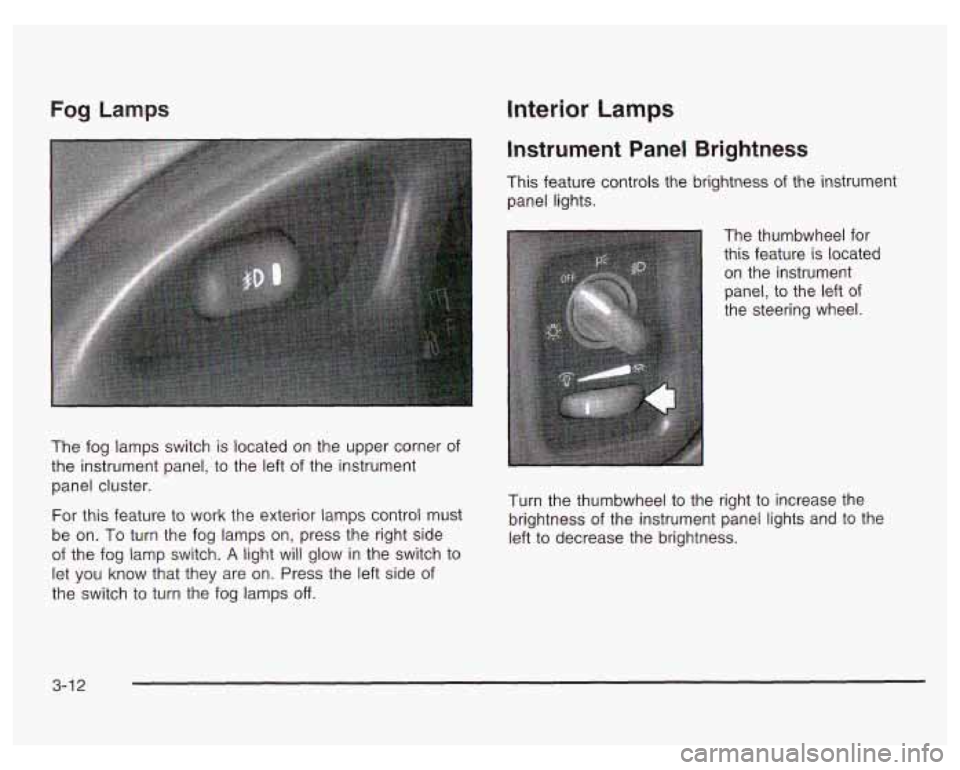
Fog Lamps
The fog lamps switch is located on the upper corner of
the instrument panel, to the left of the instrument
panel cluster.
For this feature to work the exterior
lamps control must
be on. To turn the fog lamps on, press the right side
of the fog lamp switch.
A light will glow in the switch to
let you know that they are on. Press the left side of
the switch to turn the fog lamps
off.
Interior Lamps
Instrument Panel Brightness
This feature controls the brightness of the instrument
panel lights.
The thumbwheel for
this feature
is located
on the instrument
panel, to the left of
the steering wheel.
Turn the thumbwheel to the right to increase the
brightness of the instrument panel lights and to the
left to decrease the brightness.
3-1 2
Page 142 of 378
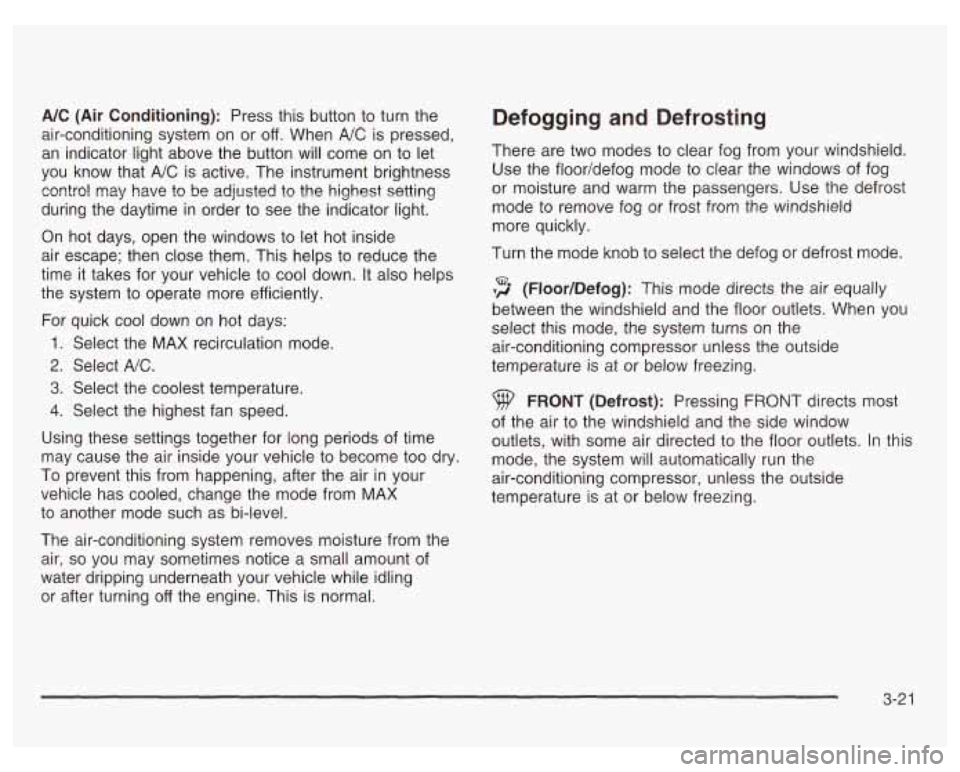
A/C (Air Conditioning): Press this button to turn the
air-conditioning system on or
off. When A/C is pressed,
an indicator light above the button will come on to let
you know that
A/C is active. The instrument brightness
control may have to be adjusted to
the highest setting
during the daytime in order to see the indicator light.
On hot days, open the windows to let hot inside
air escape; then close them. This helps to reduce the
time it takes for your vehicle to cool down. It also helps
the system to operate more efficiently.
For quick cool down
on hot days:
1. Select the MAX recirculation mode.
2. Select A/C.
3. Select the coolest temperature.
4. Select the highest fan speed.
Using these settings together for long periods of time
may cause the air inside your vehicle to become too dry.
To prevent this from happening, after the air in your
vehicle has cooled, change the mode from MAX
to another mode such as bi-level.
The air-conditioning system removes moisture from the
air,
so you may sometimes notice a small amount of
water dripping underneath your vehicle while idling
or after turning
off the engine. This is normal.
Defogging and Defrosting
There are two modes to clear fog from your windshield.
Use the floor/defog mode
to clear the windows of fog
or moisture and warm the passengers. Use the defrost
mode to remove fog or frost from the windshield
more quickly.
Turn the mode knob to select the defog or defrost mode.
,2 (Floor/Defog): This mode directs the air equally
between the windshield and the floor outlets. When you
select this mode, the system turns on the
air-conditioning compressor unless the outside
temperature is at or below freezing.
9 FRONT (Defrost): Pressing FRONT directs most
of the air to the windshield and the side window
outlets, with some air directed to the floor outlets. In this
mode, the system will automatically run the
air-conditioning compressor, unless the outside
temperature is at or below freezing.
3-21
Page 143 of 378
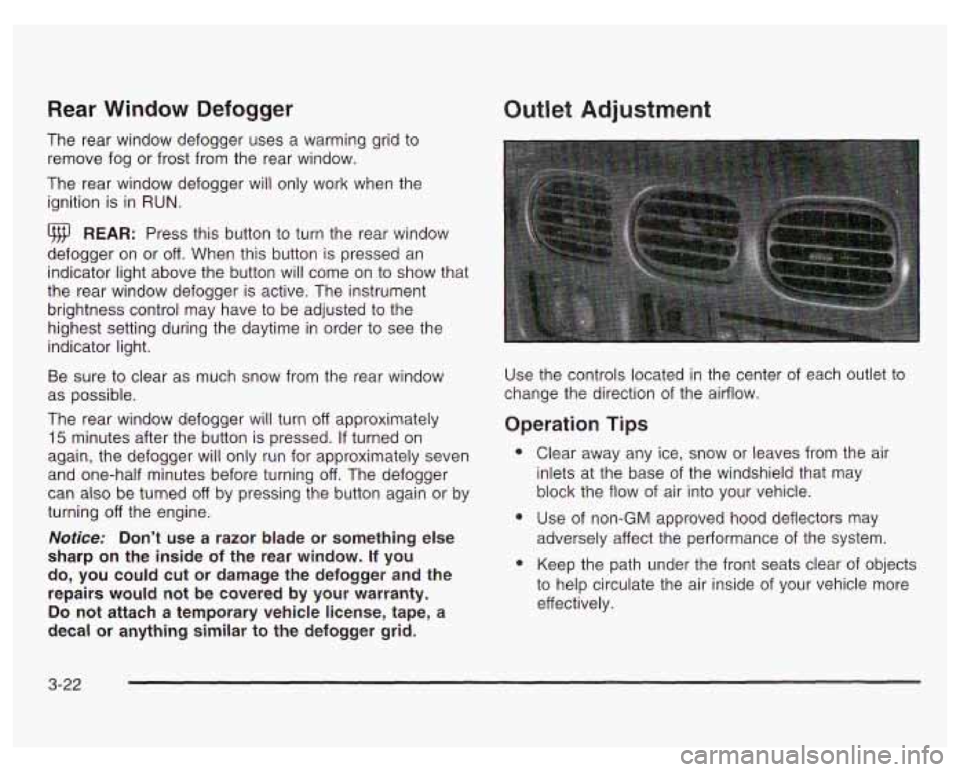
Rear Window Defogger
The rear window defogger uses a warming grid to
remove fog or frost from the rear window.
The rear window defogger will only work when the
ignition is in
RUN.
REAR: Press this button to turn the rear window
defogger on or
off. When this button is pressed an
indicator light above the button will come on to show that
the rear window defogger is active. The instrument
brightness control may have to be adjusted to the
highest setting during the daytime in order to see the
indicator light.
Be sure to clear as much snow from the rear window
as possible.
The rear window defogger will turn
off approximately
15 minutes after the button is pressed. If turned on
again, the defogger will only run for approximately seven
and one-half minutes before turning
off. The defogger
can also be turned
off by pressing the button again or by
turning
off the engine.
Notice: Don’t use a razor blade or something else
sharp on the inside of the rear window.
If you
do, you could cut or damage the defogger and the
repairs would not be covered by your warranty.
Do not attach a temporary vehicle license, tape, a
decal or anything similar to the defogger grid.
3-22
Outlet Adjustment
Use the controls located in the center of each outlet to
change the direction
of the airflow.
Operation Tips
e
e
Clear away any ice, snow or leaves from the air
inlets at the base of the windshield that may
block the flow of air into your vehicle.
Use of non-GM approved hood deflectors
may
adversely affect the performance of the system.
Keep the path under the front seats clear of objects
to help circulate the air inside
of your vehicle more
effectively.
Page 180 of 378
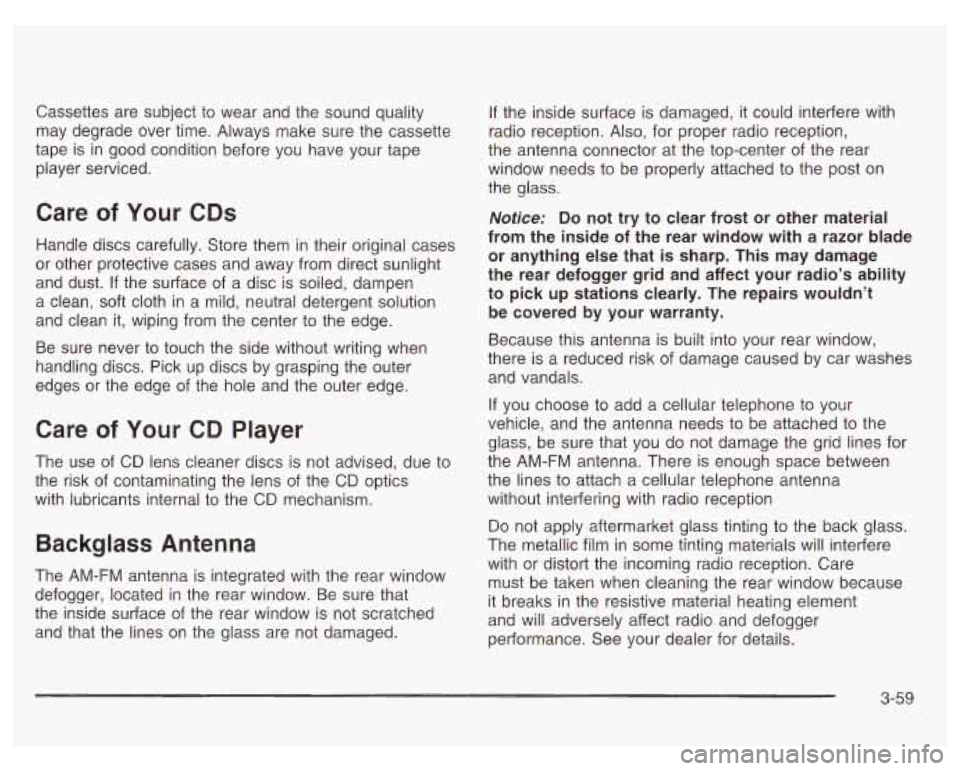
Cassettes are subject to wear and the sound quality
may degrade over time. Always make sure the cassette
tape is in good condition before you have your tape
player serviced.
Care of Your CDs
Handle discs carefully. Store them in their original cases
or other protective cases and away from direct sunlight
and dust.
If the surface of a disc is soiled, dampen
a clean, soft cloth in a mild, neutral detergent solution
and clean it, wiping from the center to the edge.
Be sure never to touch the side without writing when
handling discs. Pick up discs by grasping the outer
edges or the edge of the hole and the outer edge.
Care of Your CD Player
The use of CD lens cleaner discs is not advised, due to
the risk
of contaminating the lens of the CD optics
with lubricants internal to the CD mechanism.
Backglass Antenna
The AM-FM antenna is integrated with the rear window
defogger, located in the rear window. Be sure that
the inside surface of the rear window is not scratched
and that the lines on the glass are not damaged.
If the inside surface is damaged, it could interfere with
radio reception. Also, for proper radio reception,
the antenna connector at the top-center of the rear
window needs to be properly attached to the post on
the glass.
Notice; Do not try to clear frost or other material
from the inside of the rear window with a razor blade
or anything else that
is sharp. This may damage
the rear defogger grid and affect your radio’s ability
to pick up stations clearly. The repairs wouldn’t
be covered by your warranty.
Because this antenna is built into your rear window,
there is a reduced risk of damage caused by car washes
and vandals.
If you choose
to add a cellular telephone to your
vehicle, and the antenna needs to be attached
to the
glass, be sure that you do not damage the grid lines for
the AM-FM antenna. There is enough space between
the lines
to attach a cellular telephone antenna
without interfering with radio reception
Do not apply aftermarket glass tinting to the back glass.
The metallic film in some tinting materials will interfere
with or distort the incoming radio reception. Care
must be taken when cleaning the rear window because
it breaks in the resistive material heating element
and will adversely affect radio and defogger
performance. See your dealer for details.
3-59
Page 363 of 378
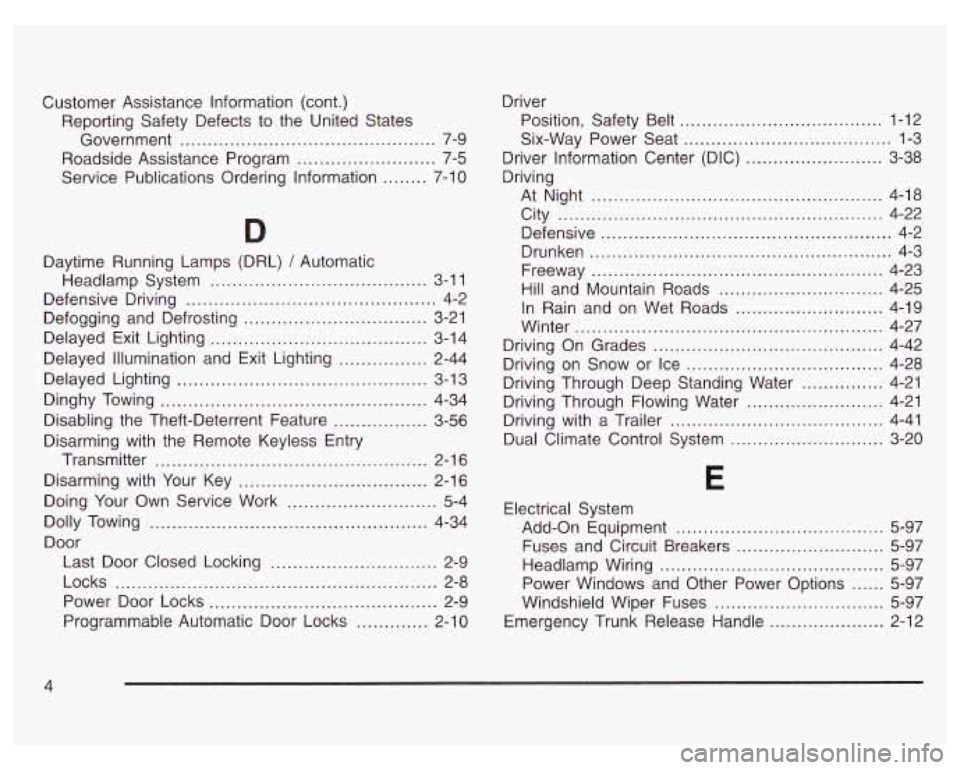
Customer Assistance Information (cont.)
Reporting Safety Defects to the United States
Government
.............................................. 7-9
Roadside Assistance Program
......................... 7-5
Service Publications Ordering Information
........ 7-1 0
D
Daytime Running Lamps (DRL) / Automatic
Headlamp System
....................................... 3-1 1
Defensive Driving ............................................. 4-2
Defogging and Defrosting
................................. 3-21
Delayed Exit Lighting
....................................... 3-14
Delayed Illumination and Exit Lighting
................ 2-44
Delayed Lighting
............................................. 3-1 3
Dinghy Towing
................................................ 4-34
Disabling the Theft-Deterrent Feature
................. 3-56
Disarming with the Remote Keyless Entry
Transmitter
................................................. 2-1 6
Disarming with Your Key
.................................. 2-16
Doing Your Own Service Work
........................... 5-4
Dolly Towing
.................................................. 4-34
Door Last Door Closed Locking
.............................. 2-9
Power Door Locks
......................................... 2-9
Programmable Automatic Door Locks
............. 2-1 0
Locks .......................................................... 2-8 Driver
Position. Safety Belt
..................................... 1-12
Six-Way Power Seat
...................................... 1-3
Driver Information Center (DIC)
......................... 3-38
Driving At Night
..................................................... 4-18
City
........................................................... 4-22
Defensive
..................................................... 4-2
Drunken
....................................................... 4-3
Freeway
..................................................... 4-23
Hill and Mountain Roads
.............................. 4-25
In Rain and on Wet Roads
........................... 4-19
Winter
........................................................ 4-27
Driving On Grades
.......................................... 4-42
Driving on Snow or Ice
.................................... 4-28
Driving Through Deep Standing Water
............... 4-21
Driving Through Flowing Water
......................... 4-21
Dual Climate Control System
............................ 3-20
Driving with
a Trailer
....................................... 4-41
Electrical System
Add-on Equipment
.......... ................. 5-97
Fuses and Circuit Breakers
................... 5-97
Headlamp Wiring
......................................... 5-97
Power Windows and Other Power Options
...... 5-97
Windshield Wiper Fuses
............................... 5-97
Emergency Trunk Release Handle
................. 2-12
4
Page 364 of 378
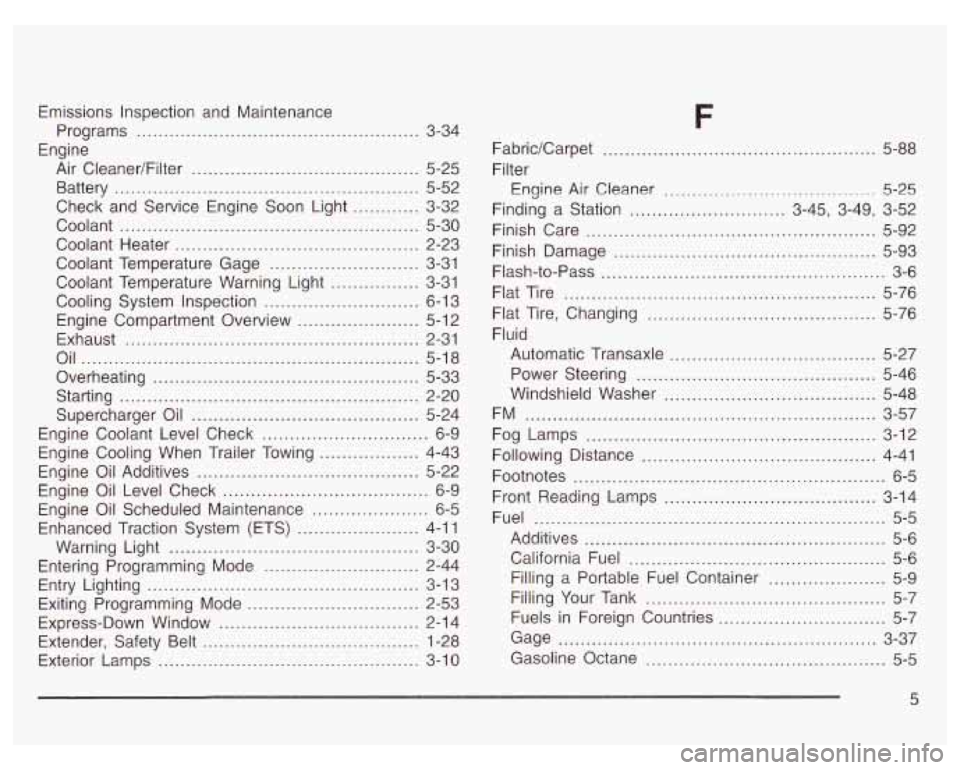
Emissions Inspection and Maintenance
Engine Programs
................................................... 3-34
Air Cleaner/Filter
......................................... 5-25
Battery
....................................................... 5-52
Check and Service Engine Soon Light ............ 3-32
Coolant
...................................................... 5-30
Coolant Heater
............................................ 2-23
Coolant Temperature Gage
........................... 3-31
Coolant Temperature Warning Light
................ 3-31
Cooling System Inspection
............................ 6-1 3
Engine Compartment Overview
...................... 5-1 2
Exhaust ..................................................... 2-31
Oil
............................................................. 5-18
Starting
...................................................... 2-20
Supercharger Oil
......................................... 5-24
Engine Coolant Level Check
.............................. 6-9
Engine Cooling When Trailer Towing
.................. 4-43
Engine Oil Additives
........................................ 5-22
Engine Oil Level Check
..................................... 6-9
Engine Oil Scheduled Maintenance
..................... 6-5
Warning Light
............................................. 3-30
Entering Programming Mode
......................... 2-44
Entry Lighting
........................ ...... 3-13
Exiting Programming Mode
.......... ...... 2-53
Extender, Safety Belt
.. ...................... 1-28
Exterior Lamps
............................................... 3-1 0
Overheating ................................................ 5-33
Enhanced Traction System (ETS)
...................... 4-1 1
Express-Down Window
................................. 2-1 4
F
, ........... FabridCarpet ........... ........... 5-88
Filter
Engine Air Cleaner ............................... :~~=:=~ 5-25
Finding a Station ............................ 3-45, 3-49, 3-52
Finish Care
.................................................... 5-92
Finish Damage
............................................... 5-93
Flash-to-Pass
................................................... 3-6
Flat Tire
........................................................ 5-76
Flat Tire, Changing
......................................... 5-76
Fluid Automatic Transaxle
..................................... 5-27
Power Steering
........................................... 5-46
Windshield Washer
...................................... 5-48
Fog Lamps
................................. , ........... 3-12
Following Distance
.......................................... 4-41
Footnotes
........................................................ 6-5
Front Reading Lamps
...................................... 3-14
Fuel
............................................................... 5-5
Additives ...................................................... 5-6
California Fuel
.............................................. 5-6
Filling a Portable Fuel Container
..................... 5-9
Filling Your Tank
........................................... 5-7
Fuels in Foreign Countries
.............................. 5-7
Gage
......................................................... 3-37
Gasoline Octane
........................................ 5-5
FM ............................................................... 3-57
5